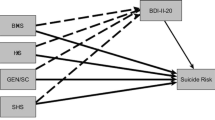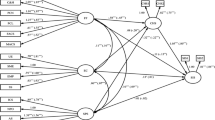Abstract
The aim in this study was to underline the importance of family environment as a significant associate of suicide probability among university students. For this aim 226 Turkish university students completed Suicide Probability Scale, Family Environment Questionnaire, Beck Depression Inventory, and Positive and Negative Affect Scale. As a result of the formulated regression analysis, after controlling for the 51% of the total variance accounted for by the control variables (i.e., gender, age, living with family versus away from family, and Grade Point Averages) and mood related variables (i.e., depressive symptoms, and positive and negative affect), family cohesion still emerged as a significant associate of the suicide probability. These findings underline the importance of family relations as a risk factor of suicide among university students.
Similar content being viewed by others
References
Abane, M., Buffard, G., Dussuyer, I., Morel, J., Quenard, O., & Vedrinne, J. (1978). Some comparative factors of suicidal behavior in young civilians and servicemen. Proceedings of the 9th International Conference for Suicide Prevention and Crisis Intervention. Helsinki: Finnish Association for Mental Health.
Angst, J., & Hochstrasser, B. (1994). Recurrent brief depression: The Zurich study. Journal of Clinical Psychiatry, 55, 3–9.
Beck, A. T., Rush, A. J., Shaw, B. F., & Emery, G. (1979). Cognitive therapy of depression. New York, Guilford Press.
Beck, A. T., Steer, R. A., Kovacs, M., & Garrison, B. (1985). Hopelessness and eventual suicide: A 10-year prospective study of patients hospitalized with suicidal ideation. American Journal of Psychiatry 142(5), 559–563.
Blair-West, G. W., Mellshop, G. W., & Eyeson-Annan, M. L. (1997). Down-rating lifetime suicide risk in major depression. Acta Psychiatrica Scandinavica, 95, 259–263.
Clark, D. A., Beck, A. T., & Stewart, B. (1990). Cognitive specificity and positive–negative affectivity: Complementary or contradictory views on anxiety and depression? Journal of Abnormal Psychology, 99, 148–155.
Clark, L. A., &Watson, D. (1991). Tripartite model of anxiety and depression: Psychometric evidence and taxonomic implications. Journal of Abnormal Psychology, 100, 316–336.
Cole, D. (1989). Psychopathology of adolescent suicide: Hopelessness, Coping beliefs, and depression. Journal of Abnormal Psychology 98(3), 248–255.
Collins, I. P., & Paykel, E. S. (2000). Suicide amongst Cambridge University students 1970–1996. Social Psychiatry and Psychiatrical Epidemiology, 35, 128–132.
Cull, J. G., & Gill, W. S. (1990). Suicide probability scale: Manual. Los Angeles, Western Psychological Services.
De Man, A. F., & Leduc, C. P. (1995). Suicidal ideation in high school students: Depression and other correlates. Journal of Clinical Psychology, 51, 173–181.
Dikencik, T. (1990). Positive and negative mood related activities and their effectiveness in alleviating depressed mood. Unpublished master’s thesis, Middle East Technical University, Ankara, Turkey.
Dukes, R. L., & Lorch, B. D. (1989). The effects of school, family, self-concept, and deviant behaviour on adolescent suicide ideation. Journal of Adolescence, 12, 239–251.
Eskin, M. (1995). Aspects of adolescent suicidal behavior among Turkish and Swedish high school students. Unpublished doctoral dissertation, Stockholm University, Stockholm.
Fowler, P. (1980). Family environment and early behavioral development. Psychological Reports, 47, 611–617.
Gençöz, T. (2000). Pozitif ve Negatif Duygu Durum Ölçeği: Geçerlik ve güvenirlik çalışması [Positive and Negative Affect Schedule: A study of validity and reliability]. Türk Psikoloji Dergisi, 15, 19–28.
Gençöz, T. (2002). Discriminant validity of low positive affect: Is it specific to depression? Personality and Individual Differences, 32(6), 991–999.
Goldney, R. D. (1981). Parental loss and reported childhood stress in young women who attempted suicide. Acta Psychiatrica Scandinavica, 64, 34–59.
Hamilton, T. K., & Schweitzer R. D. (2000). The cost of being perfect: perfectionism and suicide ideation in university students. Australian and New Zealand Journal of Psychiatry, 34, 829–835.
Harris, T. L., & Molock, S. D. (2000). Cultural orientation, family cohesion, and family support in suicide ideation and depression among African American college students. Suicide and Life-Threatening Behavior, 30(4), 341–353.
Hawton, K., O’Grad, J., Osborn, M., & Cole, D. (1982). Adolescents who take overdoses: Their characteristics, problems and contacts with helping agencies. British Journal of Psychiatry, 140, 5–21.
Hisli, N. (1988). Beck Depreysion Envanteri’nin geçerliği üzerine bir çalışma [A study on the validity of Beck Depression Inventory]. Psikoloji Dergisi 6:118–122.
Hisli, N. (1989). Beck Depresyon Envanteri’nin üniversite öğrencileri için geçerliği ve güvenirliği [Reliability and validity of Beck Depression Inventory for university students]. Psikoloji Dergisi, 7, 3–13.
Joiner, T. E. Jr., Pettit, J. W., Perez, M., Burns, A. B., Gencoz, T., Gencoz, F., & Rudd, M. D. (2001). Can positive emotion influence problem-solving attitudes among suicidal adults? Professional Psychology: Research and Practice, 32(5), 507–512.
Kağtıçıbaşı, Ç. (1983). Women and development in Turkey. International Journal of Turkish Studies, 2, 59–70.
Kağıtçıbaşı, Ç. (1987). Individual and group loyalties: Are they compatible? In Ç. Kağıtçıbaşı (Ed.), Growth and progress in cross-cultural psychology. Lisse Netherland, Swets and Zeitlinger, pp. 94–104.
Marttunen, M. J., Aro, H. M., & Lönnqvist, J. K. (1993). Precipitant stressors in adolescent suicide. Journal of American Academy of Child and Adolescent Psychiatry, 32, 1178–1183.
Moos, R. (1974). Social climate scales: An overview. Palo Alto, CA, Consulting Psychologists Press.
Moos, R. (1984). Context and coping: Toward a unifying conceptual framework. American Journal of Community Psychology, 12, 5–36.
Payne, B. J., & Range, L. M. (1996). Family environment, depression, attitudes toward life and death, and suicidality in young adults. Death Studies, 20(3), 237–246.
Pezawas, L., Stamenkovic, M., Jagsch, R., Ackerl, S., Putz, C., Stelzer, B., Moffat, R. R., Schindler, S., Aschauer, H., & Kasper, S. (2002). A longitudinal view of triggers and thresholds of suicidal behavior in depression. Journal of Clinical Psychiatry, 63(10), 866–873.
Richman, J. (1986). Family therapy for suicidal people. New York, Springer.
Rihmer, Z. (2001). Can better recognition and treatment of depression reduce suicide rates? A brief review. European Psychiatry 16, 406–409.
Tegin, B. (1980). Depresyonda bilişsel bozukluklar: Beck modeline göre bir inceleme [Cognitive impairments in depression: An analysis according to Beck’s model]. Unpublished doctoral dissertation, Hacettepe University, Ankara.
Tuğcu, H. (1996). Normal ve depresif kişilerde çeşitli faktörlere göre intihar olasılığı [Probability of suicide among normal and depressive people]. Unpublished doctoral dissertation, Hacettepe University, Ankara.
Usluer, S. (1989). The reliability and validity of the Turkish Family Environment Questionnaire. Unpublished master thesis. Boğaziçi University, Istanbul.
Watson, D. (1988). The vicissitudes of mood measurement: Effects of varying descriptors, time frames, and response formats on measures of positive and negative affect. Journal of Personality and Social Psychology, 54, 1020–1030.
Watson, D., Clark, L. A., & Carey, G. (1988). Positive and negative affectivity and their relation to anxiety and depressive disorders. Journal of Abnormal Psychology, 97, 346–353.
Watson, D., Clark, L. A., & Tellegen, A. (1988). Development and validation of brief measures of positive and negative affect: The PANAS scales. Journal of Personality and Social Psychology 54, 1063–1070.
Watson D., & Tellegen A. (1985). Toward a consensual structure of mood. Psychological Bulletin, 98, 219–235.
Author information
Authors and Affiliations
Corresponding author
Additional information
This work has been supported by the Turkish Academy of Sciences, in the framework of the Young Scientist Award Program. (TG-TUBA-GEBİP/2002-1-11).
Rights and permissions
About this article
Cite this article
Gençöz, T., Or, P. Associated Factors of Suicide Among University Students: Importance of Family Environment. Contemp Fam Ther 28, 261–268 (2006). https://doi.org/10.1007/s10591-006-9003-1
Published:
Issue Date:
DOI: https://doi.org/10.1007/s10591-006-9003-1




